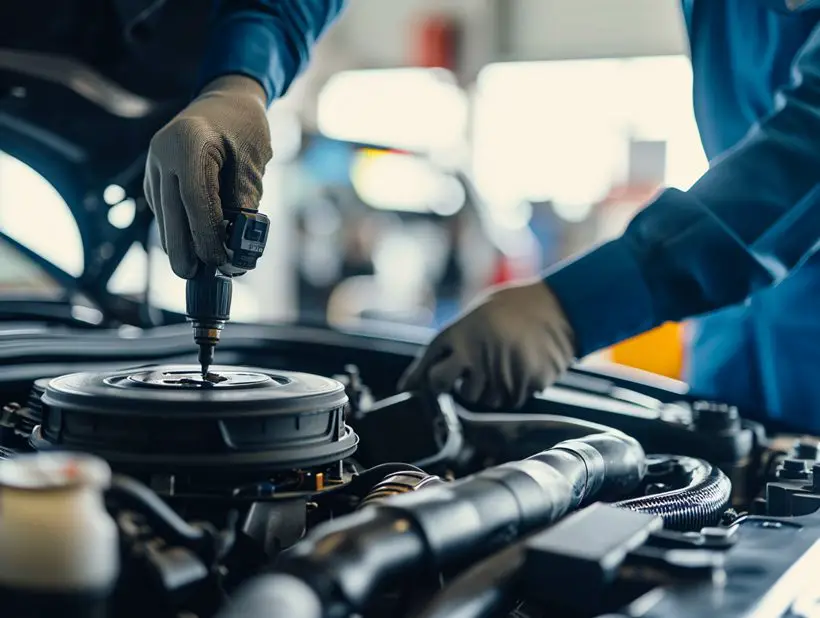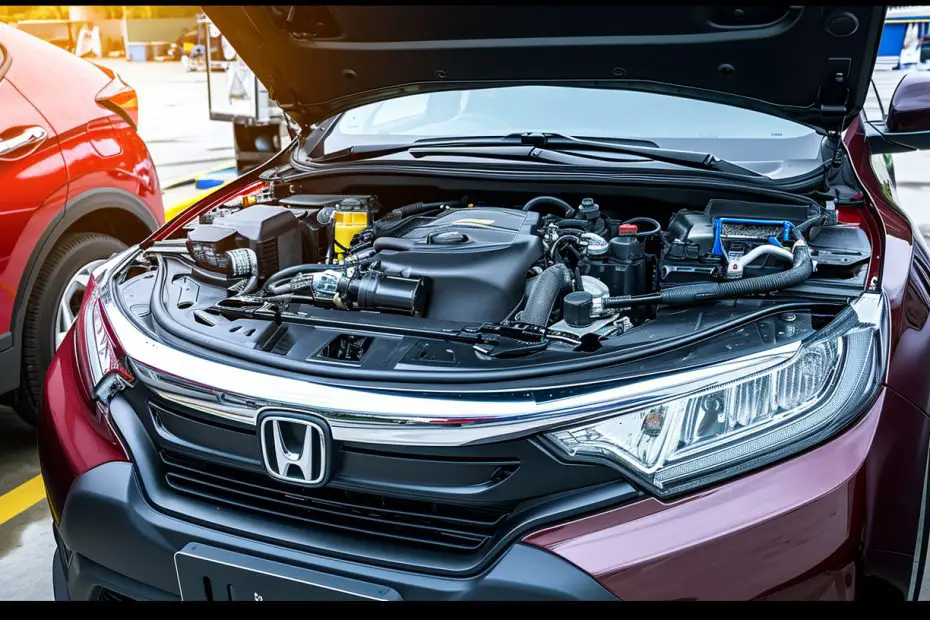Driving with a dirty windshield isn’t just annoying; it’s a safety hazard. That’s why keeping your washer fluid topped up is crucial for clear visibility. We’ve all been there‚ you hit the spray button, and nothing happens. Don’t worry; we’ll guide you through checking and filling your washer fluid, so you can keep those windows sparkling clean.
Why Checking and Filling Washer Fluid is Important
Regularly ensuring that your car’s washer fluid reservoir is full can seem like a menial task, but its significance cannot be overstated. When it comes to maintaining our vehicle, it’s crucial to remember that the little things can make a big difference. Here’s why we should always keep an eye on our washer fluid levels:
Visibility: First and foremost, the primary function of washer fluid is to aid in maintaining clear visibility through the windshield. Our ability to see the road ahead clearly is paramount, as even the smallest obstruction can lead to misjudgments and accidents.

Road Safety:
- Washer fluid is specially formulated to remove dirt, grime, and insects that can adhere to the windshield.
- In winter months, the fluid contains antifreeze properties to prevent it from freezing and to assist in melting away ice and snow.
- Dust and mud from the road can impair our vision in moments; hence having a reservoir of washer fluid is akin to having a safety net for our windshield.
Vehicle Maintenance: Consistently dirty windshields can lead to scratches because wipers drag debris across the glass. Over time, this affects the integrity and clarity of the windshield. Using washer fluid can reduce this wear and tear, prolonging the life of both the windshield and the wiper blades.
Law Compliance: In many areas, driving with a dirty windshield that impairs visibility is actually illegal. Keeping washer fluid topped up helps us avoid potential fines and points on our driving record.
Let’s not forget that checking and refilling washer fluid is a simple and quick process. Neglecting it doesn’t save us time in the long run, especially when considering the potential consequences. It’s one of the easiest aspects of car maintenance that can have a significant impact on our driving experience and safety.
Tools and Materials Needed
Before we tackle the task of checking and refilling our car’s washer fluid, it’s important to gather all the necessary tools and materials. This preparation ensures that we can complete the process efficiently and safely.
To get started, here’s what we’ll need:
- Washer fluid: Choose a fluid suitable for the climate we live in. Fluids with antifreeze properties are ideal for colder temperatures to prevent freezing.
- Funnel: This helps to pour the washer fluid into the reservoir without spilling.
- Clean rag or towel: Useful for wiping up any spills and cleaning the area around the washer fluid reservoir.
- Vehicle owner’s manual: Provides specific information about the washer fluid reservoir location and capacity for our car.
Occasionally, our windshield might still be dirty even after we’ve refilled the fluid. This could be a sign that the washer nozzles are clogged. In such cases, having a pin or needle to clear out debris from the nozzles can be handy.
Furthermore, if we’re troubleshooting issues with our windshield cleanliness, we might also require:
- Replacement washer nozzles: In case the current ones are damaged beyond repair.
- Wiper blade inspection tools: To check the condition of our wiper blades.
It’s also worthwhile to keep some distilled water on hand. If we’re in a pinch and can’t acquire washer fluid immediately, we can temporarily use distilled water with a bit of household window cleaner mixed in. However, it’s essential to note that this is not a long-term solution and does not have the antifreeze properties required in colder climates.
Locating the Washer Fluid Reservoir

Before we can inspect or refill our washer fluid, it’s essential to know where the washer fluid reservoir is located. Typically, it’s found in the engine compartment. Here’s a step-by-step guide to finding your car’s washer fluid reservoir:
- Open the hood of your car to access the engine compartment.
- Look for a translucent container with a windshield/water symbol on the cap. It’s often situated near the bottom of the windshield or to either side of the engine bay.
- The cap may vary in color but usually comes in blue or yellow for easy identification.
For those of us who prefer visual cues, most cars have the washer icon on the cap that corresponds with the icon on the dashboard. This visual harmony helps pinpoint the reservoir without confusion.
If you’re still having trouble locating the reservoir, resorting to the vehicle’s owner manual is a reliable alternative. The manual provides a diagram of the engine compartment with the washer fluid reservoir clearly labeled, making it straightforward to find.
Keep in mind that in some vehicles, especially larger ones or those with rear window washers, there might be a secondary reservoir. These are usually located in the rear of the car, often accessible through the trunk or rear hatch panel.
Pro Tip: When checking the washer fluid level, the engine should be cool to avoid any potential injuries from hot components. The same precaution should be taken when refilling the reservoir, ensuring the safety of all of us.
The design of reservoirs, with a broad funnel-like opening, facilitates an easy pour without needing funnels or additional tools. This feature takes the hassle out of maintenance and allows us to quickly get back on the road with clear visibility ahead.
Checking the Fluid Level
When it comes to maintaining visibility during adverse weather conditions, ensuring our washer fluid reservoir is adequately filled is crucial. We’ll describe how to check your fluid level effectively, so you can tackle any dirt or grime obstructing your view with a press of a button.
Firstly, we locate the washer fluid reservoir. Typically, it’s a translucent container with a blue cap marked with a windshield/water symbol. Here’s how we check the level:
- Open the hood and secure it safely.
- Find the washer fluid reservoir.
- Look for the fill line on the outside of the reservoir.
- If the fluid doesn’t reach the fill line, it’s time to add more.
What we’re aiming for is the fluid level to sit right at the fill line, neither below nor above. The reservoir design usually includes clear max and min indicators, making it easy for us to tell at a glance if we need to top off the fluid. Most modern cars feature a wide neck on the washer fluid reservoir to avoid the need for a funnel when refilling.
If we find ourselves frequently needing to refill washer fluid, it might be indicative of a leak in the system. Should this be the case, check for signs of leakage around the reservoir and along the washer fluid lines. Visible signs of leaking fluid or unexplained drops in the level warrant a closer look, possibly a visit to a mechanic for a more thorough check-up.
Keeping an eye on the washer fluid level ensures that we’re never caught off guard by muddy splash-back or a swarm of bugs on our windshield. Good visibility is not just about convenience; it’s a vital aspect of road safety. Plus, there’s something satisfying about clearing away the grime with a perfectly functioning wash system, isn’t there?
Filling the Washer Fluid
When it’s time to top off the washer fluid, we want to ensure we’re doing it safely and efficiently. Here’s a step-by-step guide so we can have our windshield clean and our view unobstructed in no time.

Locate the Reservoir Cap
Firstly, we should identify the washer fluid reservoir and remove the cap. This is usually a large, white or translucent container with a windshield/water symbol on the cap.
Select the Right Fluid
It’s crucial to choose the right washer fluid to avoid any damage to our vehicle. In colder climates, we might opt for a fluid with antifreeze properties, whereas in warmer regions, a standard washer fluid will do.
Pouring the Fluid
Using a funnel, we’ll carefully pour the washer fluid into the reservoir until it reaches just below the fill line. Overfilling can cause spills and wastage.
Check for Leaks
After we’ve refilled the reservoir, it’s wise to check for any potential leaks. We should look for puddles or drips under the car and around the reservoir.
Essential Tips:
- Always check the washer fluid in a well-lit environment to accurately gauge the fluid level.
- If the reservoir has dirt or debris, we’ll want to clean it before adding new fluid to prevent clogging.
- After filling, give the system a quick test to ensure it’s working as expected.
By giving our washer fluid a top-up, we’re directly contributing to safe driving practices by maintaining clear visibility. It’s a quick maintenance task that we can perform regularly, ensuring we’re always road-ready regardless of the weather conditions.
Remember, washer fluid is not a one-size-fits-all solution; we must be mindful of the formula we use, especially if we face freezing temperatures or have special requirements for our vehicle’s windshield coating.
Troubleshooting Issues
When we’re faced with a malfunctioning washer system, it’s crucial to identify and tackle the issue promptly. We’ve put together a comprehensive troubleshooting guide to help diagnose and resolve common problems with washer fluid systems.

Identifying the Problem
To effectively troubleshoot, we first need to identify what’s going wrong. Common signs of washer fluid system issues include:
- No spray: When the washer lever is activated, and nothing comes out.
- Weak spray: Only a trickle of fluid sprays onto the windshield.
- Uneven spray: Fluid sprays unevenly or at incorrect angles.
Common Washer Fluid System Issues
Let’s take a closer look at some typical issues and their potential fixes.
- Blocked Nozzles: Dirt or debris can clog the washer nozzles, leading to weak or no spray. Use a pin to clear blockages, and always be gentle to avoid damage.
- Faulty Pump: A washer pump that isn’t working will prevent fluid from reaching the nozzles. Listen for a humming sound when activating the spray; no sound could indicate a pump failure.
- Leaky Reservoir: Washer fluid can’t be delivered properly if there’s a leak in the reservoir. Inspect for cracks and consider using a sealant for minor damages or replace the reservoir for substantial issues.
- Electrical Problems: If the pump is unresponsive, check the fuse and wiring. Replacing a blown fuse or repairing wires often solves the problem.
Checking for Electrical Faults
We’ll need to ensure the washer system’s electrical components are functioning correctly. This involves inspecting the fuse, wiring, and connections.
| Component | Check Method |
|---|---|
| Fuse | Look for breaks or burn marks. |
| Wiring | Inspect for frayed edges. |
| Electrical Ports | Check for corrosion or damage. |
If faulty wiring is detected, it’s best to seek professional help to avoid further complications. Regular maintenance of these components helps prevent future electrical issues.
By addressing these common problems ourselves, we can save time and resources. Stay vigilant for early signs of trouble and remember, routine checks can prolong the life of our washer fluid system ensuring clear visibility on the road.
Conclusion
Maintaining a full washer fluid reservoir and a fully functional system is crucial for our road safety. We’ve walked through the necessary steps to ensure our windshield is always clear, from checking levels to troubleshooting common problems. Let’s remember to routinely inspect and maintain our washer fluid system‚ it’s a simple task that plays a significant role in our driving experience. By staying proactive, we can keep our view unobstructed and our journeys safe.
